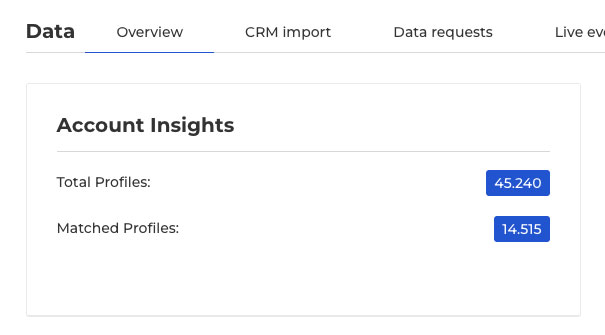What is visitor recognition and why is it important to get started with it? We’ll show you in this blog how you can increase on-site recognition and what you can ultimately do with this recognition in your marketing channels.
Online recognition, what does that mean?
Recognition, it’s in the name, means that you can recognise visitors who come to your website as a person. Within the CDP of Spotler Activate, we call this a profile. Every visitor who comes to the website has a profile, and within this profile we store search and orientation behaviour. This means that we follow the visitor during his or her visit to the website and record his or her interests and customer journey.
Within all of these profiles, we distinguish between known profiles and anonymous profiles. Known profiles are profiles in the Customer Data Platform where we also know who is behind the profile. This means that we at least know their email address. We have been able to store this email address with the profile because the visitor has made it known during the session. Possible reasons for this include logging in with an account, signing up for the newsletter, or by placing an order or booking.
Below is an example of recognition in the Customer Data Platform. This shows what percentage of visitors who visited the website are known and what percentage is anonymous.

Why is recognition important?
Whether a profile in the CDP is known or anonymous, does not matter for building the profile and storing search and orientation behaviour.
However, recognition is much more important for (re)targeting visitors on different marketing channels. It is also important to build a cross-device profile. As we described above, a profile is created for every website visitor in the CDP. However, it can of course happen that visitors use multiple devices during their customer journey. The desired situation is to then not store two separate profiles, but to combine these profiles, in order to be able to offer an optimal customer journey on all devices. This can be achieved by targeting recognition. Because as soon as someone with an email address is known on for example a desktop, and we see a profile with that email address also on mobile, we can recognise that person as one person.
Increase recognition
As we indicated above, visitor recognition is therefore very important. But not all visitors to your website will make themselves known. Therefore, it is important to take certain actions to increase recognition.
First, it is important that the CDP can well record all possible ways in which a website visitor can make himself or herself known. Think of contact forms, newsletter registration forms or for example by creating an account.
Next, you can increase recognition by loading historical customer data. We do this so that we can link visitors who identify themselves again to profiles that have taken certain actions in the past. So we don’t see it as a new profile, but as someone who has already made a purchase several times, and we can combine that information.
In addition, it is important to recognise if a visitor comes from the newsletter to the website. This can be done by adding a recognition to the URL of the click outs of a newsletter, in which the CDP can recognise the email address.
Finally, recognition can be increased by using on-site profiling campaigns. Profiling campaigns are campaigns that target the collection of the email address. There are different possibilities in this, but it mainly involves enticing visitors to leave their email address during the website visit.
The importance of persuasion in recognition
To persuade visitors to sign up for the email campaign, almost always use different persuasion principles, sometimes even multiple at once. To increase visitor recognition, an incentive is often offered in exchange for leaving their personal data, such as offering a discount or free product. This is a form of persuasion, specifically reciprocity.
Persuasion is an umbrella term for (social) influence. Social influence can influence beliefs, attitudes, intentions, motivations, and behaviour. Trying to influence the behaviour of a person is an important point in the marketing roadmap, and there are several persuasion principles that play a role in this.
Online, persuasion is used on a large scale to increase recognition on the site. The most famous persuasion principles are the seven influencing principles of Robert Cialdini. In this article, we will focus on the ones that work best for the email (unsubscribe) campaign.
One of the best persuasion principles for this specific campaign is reciprocity. The principle of reciprocity comes down to wanting to pay back or do something in proportion to what the other has offered, as we also described in the paragraph above. For example, getting a discount or the chance to win something (such as a free hotel room), a visitor will feel obligated to give something back. This means that visitors feel the need to sign up for a newsletter or even make a purchase, because there is a ‘free’ discount.
In addition, it is also the case that someone will be more likely to make a purchase or booking after signing up. This is not due to reciprocity, but due to the registration (which was also made possible by the principle of reciprocity). Once someone has signed up, there is the so-called sunk costs; someone has already invested time, money, or energy into something, and are therefore more likely to invest even more time, money, or energy. The idea behind this is that it is a shame to completely let go of the investments made. You often see this reflected in the same session, someone who receives a discount code will often redeem it in the same session.
Another persuasion principle is loss aversion. This principle describes our natural aversion to loss. The pain caused by loss is about 2 to 6 times greater than the joy that comes with winning. If you use this principle in an email registration campaign, this means that ‘gain framing’ (sign up for our newsletter and receive 10% discount) must be changed to ‘loss framing’ (don’t miss out on your 10% discount).
Pointing out the exclusivity of signing up for a newsletter feels like a KPI, but it is also a persuasion principle. Exclusive products, content, or access to sales (pre-sale) make the visitor feel special. The principle of exclusivity has some similarities to the principle of scarcity; products or services that are difficult to obtain are usually perceived as more valuable and therefore the availability of a product or experience can be an indication of its quality. This is why exclusivity is such a powerful persuasion principle and KPI.
A/B testing
To gauge the most suitable form of the campaigns in place, you can use A/B testing. This can be done on the basis of text (trying out different persuasion principles, or offering an incentive), design (use of colours or different images), and appearance (for example inline between the content or via a pop-up). It is important that you test one of the components at a time, and not everything at once. When you test multiple components at the same time, an achieved result can never be traced back to a specific adjustment, but only to a series of adjustments that may not all have been equally effective. You then don’t know which specific adjustment caused the positive or negative effect.

Conclusion
Although you can target both anonymous and known visitors, recognising visitors certainly has added value. It is therefore useful for a company to increase recognition on its website, and Spotler Activate can help with this. By storing and configuring customer profiles completely AVG-proof and without the use of third-party tracking cookies, you can recognise people on your site. Based on their personal preferences, you can then use the most suitable channels and campaigns to convert this data into conversions.
Schedule an online demo
Do you want more information about how to best target (re)target customers and how a CDP can help you with this? Request a free and non-binding demo of Spotler Activate.
